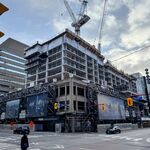S
socialwoe
Guest
Okay in light of new election promises concerning transit got me thinking of all the new expansion/extension projects that could be done. Here's my ideas:
1. Eglinton-
elevated structure between Avenue Rd and Bayview Ave. Continues underground west to Black Creek Dr and east to Don Mills Rd.
2. Eglinton East-
new RT west to Victoria Park (eventually connecting to Don Mills)
3. BD East-
extension to Kingston Rd (eventually converted to Eglinton Line)
4. SRT East-
extension to Toronto Zoo via Malvern/ Morningside Hts. Possible conversion to subway technology but run on surface or elevated.
5. Sheppard East-
conversion to LRT east of Fairview Mall. Runs full length of
Sheppard to Meadowvale (Zoo).
6. BD west-
extension to Sherway Gardens. MT terminal relocated from Islington to Sherway.
7. Yonge North-
extension to Steeles (possibly to Lanstaff GO)
8. Weston-Geogretown Corridor Transit-
new RT from Waterfront (Toronto Portlands-Exhibition) to Eglinton and beyond.
9. Eglinton West-
extension from Black Creek to Renforth and Pearson Airport.
10. Queen-Lakeshore-
a new line originally between Ronchesvalles and Broadview. Extensions west via Queensway and Lakeshore to Long Branch and east to Warden/Kingston Rd.
11. Don Mills-
an eastern leg of the WGCT line running up Lakeshore East GO to Gerrard Sq then up Pape, Millwood, Overlea and Don Mills to Steeles with provisions to head into YR eventually.
12. Spadina North-
extension into Vaughan and in long term Woodbridge.
13. Hwy 27 Rocket-
new RT line linking north Rexdale, Albion Mall, Humber college, Woodbine Racetrack and Fantasy Fair, and a new GO station to Eglinton RT and further south Etobicoke Civic Ctr to BD line.
14. Sheppard West-
Fills missing link between Yonge and Downsview possibly further west to Weston.
15. Kingston RT-
In conjuction with local bus service the RT only stops at major transfer points from Queen/Coxwell to as far east as Highland Creek before following Lawson/Port Union to Rouge Hill GO.
If the funds and resources were available which of any one of these projects would you approve of and why?
1. Eglinton-
elevated structure between Avenue Rd and Bayview Ave. Continues underground west to Black Creek Dr and east to Don Mills Rd.
2. Eglinton East-
new RT west to Victoria Park (eventually connecting to Don Mills)
3. BD East-
extension to Kingston Rd (eventually converted to Eglinton Line)
4. SRT East-
extension to Toronto Zoo via Malvern/ Morningside Hts. Possible conversion to subway technology but run on surface or elevated.
5. Sheppard East-
conversion to LRT east of Fairview Mall. Runs full length of
Sheppard to Meadowvale (Zoo).
6. BD west-
extension to Sherway Gardens. MT terminal relocated from Islington to Sherway.
7. Yonge North-
extension to Steeles (possibly to Lanstaff GO)
8. Weston-Geogretown Corridor Transit-
new RT from Waterfront (Toronto Portlands-Exhibition) to Eglinton and beyond.
9. Eglinton West-
extension from Black Creek to Renforth and Pearson Airport.
10. Queen-Lakeshore-
a new line originally between Ronchesvalles and Broadview. Extensions west via Queensway and Lakeshore to Long Branch and east to Warden/Kingston Rd.
11. Don Mills-
an eastern leg of the WGCT line running up Lakeshore East GO to Gerrard Sq then up Pape, Millwood, Overlea and Don Mills to Steeles with provisions to head into YR eventually.
12. Spadina North-
extension into Vaughan and in long term Woodbridge.
13. Hwy 27 Rocket-
new RT line linking north Rexdale, Albion Mall, Humber college, Woodbine Racetrack and Fantasy Fair, and a new GO station to Eglinton RT and further south Etobicoke Civic Ctr to BD line.
14. Sheppard West-
Fills missing link between Yonge and Downsview possibly further west to Weston.
15. Kingston RT-
In conjuction with local bus service the RT only stops at major transfer points from Queen/Coxwell to as far east as Highland Creek before following Lawson/Port Union to Rouge Hill GO.
If the funds and resources were available which of any one of these projects would you approve of and why?




